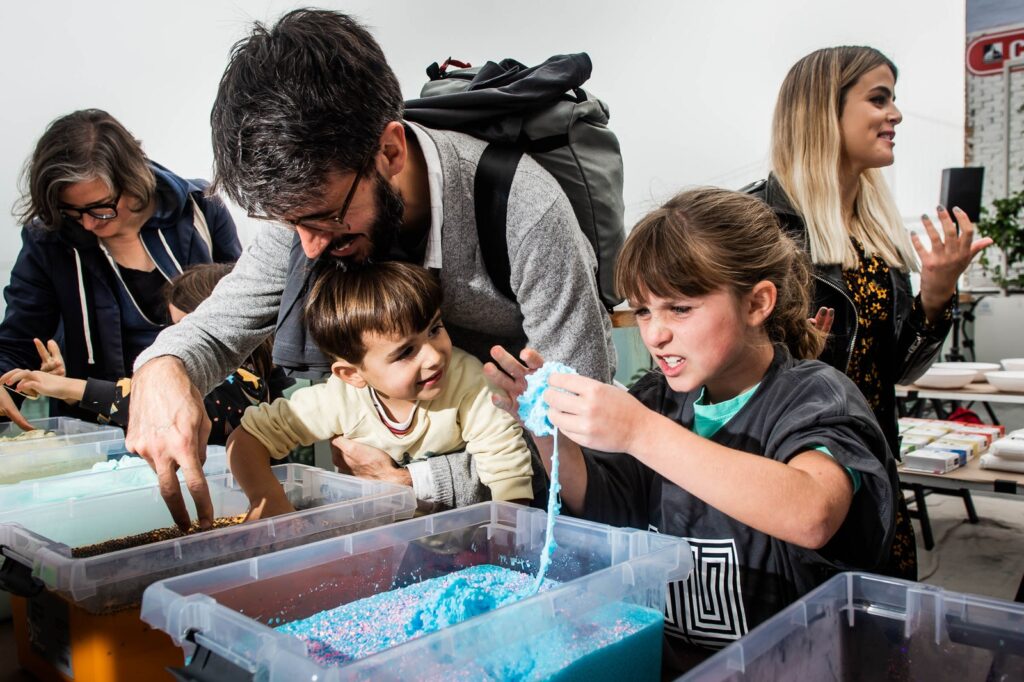At WIRED25’s Saturday slime workshop, adults were invited to give in to the powerful, long-suppressed urge to squish gooey things and smell a variety of nostalgic eaux de childhood. Bins full of bright pastels reminiscent of a bubble tea shop wafted scents of coconut cream pie, brown sugar, bread, and oregano. Yes, you could touch all of it. Though children took the lead, a brief visual survey revealed that the over-30 crowd also appreciates a tactile indulgence.
Katie Anstett, a 16-year-old slime-trepreneur of Instagram fame, guided newbies as they shaped their own goo, as part of the workshop hosted by WIRED’s Louise Matsakis. Starting from one of two different bases comprised of school glue and scented oil that smells like Fruit Loops, crafters added coloring and soft clay to create what Anstett calls a “butter” texture, and selected from a table of crunchy add-ins like mini robots, plastic fruit slices, and pinky-nail-sized gummy bears.
“Just get creative with it,” Anstett said, encouraging parents to have a go along with their kids. “This is for everyone.” A teenager named Claire wore a toothy grin as she drizzled glittery purple “cloud” slime in her palm. Though it’s her favorite type, she hasn’t figured out how to make it at home. But she has tried her hand at glow-in-the-dark slime, with some success. A certain eight-year-old who shares the author’s genetic makeup got so creative with it that, at time of press, her hands remain bright blue.
Slime mania hit a peak in 2017, when 2 million slime videos were uploaded to YouTube. Though traffic is down slightly, the craze doesn’t yet appear to be fading. Earlier this year, Matsakis joined some 5,000 attendees and reported from the World Slime Convention in Hershey, Pennsylvania. Some kids have reportedly watched slime videos to help them fall asleep. Part of the allure could be ASMR— auditory sensory meridian response, that tingling felt in the head or neck that follows watching or listening to something to which the viewer has a highly sympathetic reaction. The slimes on social media also tended to be brightly colored, scented like candy, and made with easy-to-find materials—a wellspring for tween tech natives. YouTube influencers like Courtney Lundquist, Karina Garcia, and Gillian Bower (they are predominantly female) each boast hundreds of thousands of followers and upload new material weekly. Their tutorials help viewers craft everything from sparkly cloud slime, which looks like fluffy spiderwebs as you pull it apart, to crunchy slime, which usually contains plastic or foam beads and makes a slight popping sound when you squeeze it, reminiscent of bubble wrap and pop rocks.
Anstett, a high school junior from San Jose, California, has almost 160,000 followers on Instagram (@slimedesigners) and a lucrative business on Etsy, where she sells handcrafted slimes inspired by Jiffy corn muffins, red bean buns, and the ghostlike character No Face from Hayao Miyazaki’s Spirited Away. Thai food inspires a lot of her creations, Anstett says, looking over at a bin full of orange Thai milk tea–themed “glossy” slime.
When she started experimenting with slime in 2016, there were no recipes available on the internet, so Anstett found her own formula through trial and error. She networked with other influencers, reviewing their slimes and learning from their methods, and pretty soon she’d built a devoted following.
“This entire experience has changed my life,” Anstett says. Though she loves the community and room for creativity slime affords her, she doesn’t foresee a career making the stuff. Anstett is setting her sights on law school.

